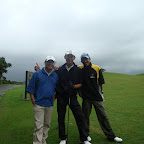 1. Equipment
1. Equipment
Taking the right equipment to the course involves both rules and etiquette. The rules place a limit of 14 clubs in each golfer's bag. There is no minimum number of clubs you must have, but borrowing clubs from your partners is not a good idea. Borrowing clubs during a round is permissable under certain circumstances, but it is against the rules in most. So it's best for a beginner to simply make sure he or she has all the clubs they need, up to the maximum of 14.
Even if you're not playing strictly by the rules your first time out, you won't want to be badgering your playing partners to borrow equipment.
Make sure you have in your golf bag plenty of tees and, most importantly, plenty of golf balls. After all, if it's your first time out, you'll probably be losing a lot of balls! And take a ballmark repair tool with you (more on course care below). These are small tools that can be found for a couple bucks at most pro shops. You will need one to repair ballmarks on the greens.
2. Make a Tee Time, then Make the Tee Time
For most rounds of golf you play, you'll want to reserve a tee time. You can get a tee time by calling the golf course the day before (or several days prior, depending on a course's policy) you want to play and requesting a specific time.
Once your group has reserved a tee time, say, 10:14 a.m., it's really nice to actually make the tee time. Plan to get to the golf course at least 30 minutes early, just to be safe (many golfers arrive up to an hour early to warm up). If a tee time is missed, your group might lose its spot and have to wait around for another opening, which can take hours on a busy day. So while tee times are not always required, it's a good idea to have one.
And if you do get to the course early, spend the time wisely by hitting a few balls on the driving range, and putting on the practice putting green.
3. Dress the Part, and Tip When Necessary
Many golf courses have dress codes. Find out what the dress code is at the course you're playing and dress appropriately. A pair of khaki shorts or slacks and a collared golf shirt will almost always meet the requirements, but it's a good idea to check beforehand.
Golf shoes are usually not required, and golf gloves are always up to the golfer, but both are good things to have and use.
As for tipping: Yes, you might have to tip at some golf courses. At municipal courses tipping is almost never an issue. If playing a private, semiprivate or upscale public course, bring some extra bills to tip the "cart jockeys" (the guys or gals who might greet you on arrival with a cart, or carry your clubs to and from your car) and the beverage cart drivers (the guys or gals who sell drinks around some courses from a well-stocked golf cart). The amount of your tip goes up in direct proportion to the green fee.
undefined
4. Teeing Off
On the teeing ground, you must place your ball between the tee markers, either even with them or up to two club lengths behind them. Never in front of them. Tee markers are usually small, colored cones or stones or some other similar indicator. For example, if you're playing from the white tees, look for markers painted white.
As for who tees off first ...
5. Honors, Away and Ready Play
The player who has "honors" tees off first. On the first tee, this can be decided randomly (draw straws, play paper-rock-scissors, whatever). On ensuing tees, the player with the best score on the preceding hole goes first, the second-best score goes second, and so on. Ties carry over to the next tee box, so you keep your place in the rotation until you beat someone on a hole.
"Honors" determines who tees off first; what about the order of play on shots from the fairway? He who is "away" (or "out") leads the way. The player who is farthest from the hole always plays first, from any position on the golf course other than the tee box. The exception is when all members of the group have agreed to play "ready golf," meaning hit-when-ready. Ready golf can be played when a group is trying to speed up the round.
6. Play It As It Lies
One of the most fundamental principles of golf - an idea that much of the Rules of Golf is built around - is "play it as it lies." What that means is pretty simple - don't move or touch the ball! Where it comes to rest, whatever state it is in, you most likely have to play it as is.
There are exceptions spelled out in the Rules of Golf, but if you want to play by the rules, a good rule of thumb is this: Don't move the ball, don't touch it, don't pick it up unless you are certain that you are allowed to do so under the Rules.
One exception that is always in place: You are allowed to pick up and clean the ball when it's on the putting green (place a ballmarker just behind the ball before picking it up on the putting green).
7. Out of Bounds & Lost Balls
Out-of-bounds should be clearly marked around the golf course, usually through the use of white stakes or white lines. The penalty for OB is stroke-plus-distance; that is, add one stroke to your score, then go back to where you hit the shot from and hit it again. Of course, that takes time. At busy golf courses you won't have that time because there is likely to be a group behind yours waiting to play. So when you think you've hit a ball out of bounds, you'll need to play a second ball (called a "provisional ball") off the tee so you won't have to retrace your steps if the first ball really is OB.
Make sure to announce to your playing partners that you are hitting a provisional, then re-tee after everyone else has hit and play your provisional tee ball. If you find your first ball and it is actually in bounds, then you play the first ball. If you can't find your first ball, or find it out of bounds, then play your provisional ball (in which case your provisional ball off the tee counts as your third stroke, so your next shot will be your fourth).
The same applies to lost balls. If your shot goes deep into the woods, the penalty for a lost ball is stroke-plus-distance, so hit a provisional. (Balls hit into water are treated diffrently, see No. 9.)
8. Keep Up the Pace
Slow play has always been an issue on golf courses, and it's even more important as a beginner to be aware of your pace of play. You don't want to keep golfers behind you waiting, just as you probably don't want to be kept waiting yourself by slow groups ahead.
Always be prepared to play when it is your turn to hit. Don't wait until it is your turn to figure out which club to use, or to determine the line of a putt; use the time while others are hitting to make those decisions, so that when it's your turn you can step right up and play.
If your group is slower than the group immediately behind yours - if your group is holding up another group - it's good etiquette to allow the faster group to play through. Not all groups will want to do this, but many will, and all that do will be very grateful for your show of etiquette.
9. Water Hazards
Water hazards should be clearly marked on golf courses. Yellow stakes or lines indicate a water hazard; red stakes or lines indicate a lateral water hazard (a lateral water hazard is a water hazard that runs alongside, rather than across, the line of play).
You can try to play a ball that is in the water, but that's generally a bad idea. Instead, for "regular" water hazards, take a 1-stroke penalty and drop a ball at any point behind the spot where your original ball crossed into the water hazard, but on the same line of play (think of it this way: look at the flag, and look at the spot where your ball crossed into the water hazard; now imagine a straight line drawn back from the flagstick to that spot; then imagine that line extending back behind you - that's the line on which you must drop).
For lateral water hazards, drop within two club lengths of the spot where the ball crossed the margin of the hazard (no nearer the hole), or on the opposite side of the hazard at an equidistant spot.
10. Course Care and Safety
Golf courses are there to be enjoyed by all golfers, so part of your responsibility is taking care of the course while you are on it. If you are using a golf cart, always observe the posted cart rules. Even better, a good idea is to keep the cart on the cart paths at all times (carts damage the grass). Never drive a golf cart close to or through a hazard (bunkers, ponds, etc.) or within 50 yards of a putting green.
Always repair your ballmarks (also called pitch marks) on the green. Ballmarks are indentations sometimes made in the putting green when a ball thumps to the surface.
Always repair your divots in the fairway. Divots are the scrapes or chunks of turf sliced off (or dug up) by iron shots. Repairing a divot might mean picking up the sod that you've chopped up and placing it back in the resulting scrape; or it could mean pouring sand or seed into the spot of the divot. If sand or seed are provided by the course (usually in a container that rides on the golf cart), that's what they want you to do.
Always rake sand bunkers after you've hit your shot to smooth out the sand so that ensuing golfers don't have to play out of your footprints. (And by the way, another basic rule to know is that, when in a bunker, you are not allowed to ground the club; that is, your club must not touch the sand except in the process of making the stroke.)
And always be aware of other golfers on the course, especially during your swing. Golf clubs can do serious damage if they strike another golfer, and so, too, can golf balls at close range. Don't play your shot until the group ahead is out of range.


























































































